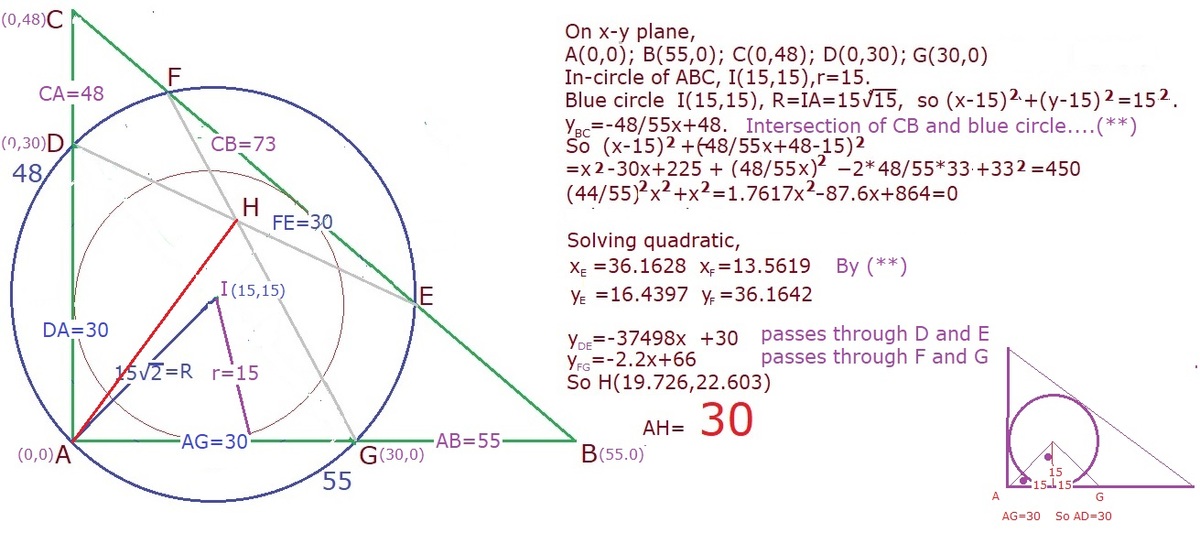A Geometry Problem by Haosen Chen
As shown in the figure,
I
is the incenter of
△
A
B
C
and
∠
B
A
C
=
9
0
∘
.
A
is on
⊙
I
and
D
,
E
,
F
,
G
are the intersections of
⊙
I
and
A
B
,
B
C
,
C
D
.Let
H
be the intersection
of
D
F
and
E
G
.Now given
A
B
=
5
5
,
C
A
=
4
8
, what's the length of
A
H
?
The answer is 30.
This section requires Javascript.
You are seeing this because something didn't load right. We suggest you, (a) try
refreshing the page, (b) enabling javascript if it is disabled on your browser and,
finally, (c)
loading the
non-javascript version of this page
. We're sorry about the hassle.
3 solutions
Can you explain why BD=BE and CF=CG.
Log in to reply
If you consider D2, E2 as points of contact of original incircle with sides AB and BC respectively then B D2 = B E2. D D2 = E E2 therefore BD = BE. The same logic applies for CF = CG.
Let ω be the incircle of Δ A B C such that A ′ , B ′ , and C ′ are the intersections on B C , A C , and A B respectively. Let r denote the radius of the incircle and R the radius of the larger circle. Let E H = x and H F = y .
To solve for r , notice that Δ A B C = s r , where s = 2 a + b + c , so r = 1 5 .
Notice that A C ′ = D C ′ = A B ′ = G B ′ = r . So D G = 2 r 2 and R = r 2 . Also ∠ A D G = ∠ A G D = 4 5 ∘ .
Since Δ D G H ∼ Δ E F H , D H = E H 2 = x 2 and G H = H F 2 = y 2 .
Notice that D − I − G is collinear since ∠ B C A = 9 0 ∘ = ∠ D E G = ∠ D F G and by Converse of Thales Theorem.
Also D G = B E and C G = C F since D C ′ = E A ′ = G B ′ = F A ′ = r .
By law of cosines, we obtain ∠ A B C = cos − 1 ( 7 3 5 5 ) and ∠ A C B = 9 0 − cos − 1 ( 7 3 5 5 )
After a series of angle chasing, ∠ G D F = 2 cos − 1 ( 7 3 5 5 ) . So ∠ A D H = 4 5 + 2 cos − 1 ( 7 3 5 5 ) .
By law of cosines and then pythagorean, 1 8 0 0 = 1 2 5 0 ( 7 3 5 5 ) + ( x 2 + y ) 2 ; 1 8 0 0 = 6 4 8 ( 7 3 4 8 ) + ( x + y 2 ) 2 . So D H = 1 5 0 7 3 2 .
By law of cosines, A H 2 = 3 0 2 + ( 1 5 0 7 3 2 ) 2 − 2 ( 3 0 ) ( 1 5 0 7 3 2 ) cos ( 4 5 + 2 cos − 1 ( 7 3 5 5 ) )
A H 2 = 3 0 2 + ( 2 2 5 0 0 ) ( 7 3 2 ) − 2 ( 3 0 ) ( 1 5 0 7 3 2 ) ( 2 5 7 3 2 ) .
A H 2 = 3 0 2
A H = 3 0 .
The bash part can actually be done by hand using formulae from trigonometry.
wooo kilala ko niiiii
This is my main account. Just ask questions if you need. Btw the computational part can be ignored by showing Δ A D E ≅ Δ A H E .

In triangle ABC we first find r and locate 'I'. Then draw the circle I(15,15), R=
1
5
2
.
As can be seen from the small sketch, we can locate D and G.
We calculate E and F coordinates through Intersection of blue circle and BC.
Find equations of DE and FG.
Locate H, intersection of DE and FG.
Finally Distance of H from A(0,0).
B D = B E , C F = C G , A D = A G = E F = 3 0 , ∠ D I G = 1 8 0 , ∠ D F G = ∠ D E G = 9 0 , A F ∥ D E , A E ∥ G F .
It can be shown that point H is an orthocentre of a triangle A E F and that ∠ E A F = 4 5 . For any triangle A B C , A H = tan ( A ) B C . In our case A H = tan ( 4 5 ) E F = 3 0 .
For more info on orthocentre property mentioned see my note .